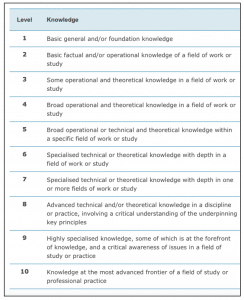From Vermont to New Zealand: Next Generation Approaches to Certifying Student Readiness for Future Success
Education Domain Blog
Meaningful qualifications are credentials and degrees awarded based on demonstrated mastery of the skills, knowledge and dispositions students need for success in higher education, the modern workforce and in life. More meaningful qualifications can motivate students, improve college persistence and graduation rates, reduce retraining costs for employers and promote lifelong learning.
This post highlights New Zealand as an example of an education system that effectively uses qualifications frameworks to make credentials more meaningful to students, educational institutions and employers. It also highlights how Vermont is using proficiency-based graduation requirements to lend more meaning to credentials in that state.
The New Zealand Qualifications Framework (NZQF)
The New Zealand Qualifications Framework (NZQF) is aligned across primary and secondary education, higher education and workforce certifications. According to the New Zealand Qualifications Authority, the NZQF “is the heart of New Zealand’s education system. All qualifications…come with an assurance of quality that is recognised and trusted worldwide….This allows [students] to benchmark [their] level of skill and knowledge on the NZQF and makes it easier for countries and regions to compare qualifications. For employers it makes explicit what graduates can ‘do, be and know’ on completion of the qualification. And for all parties it lays out pathways to further education, employment and/or a contribution to their community.”
The NZQF is structured into 10 levels. As students earn certificates and progress up the levels, they begin to specialize in their knowledge and “level up” to earn diplomas and degrees.
The following chart articulates the knowledge and skills needed to advance to higher levels in the qualifications framework. Level 1 is based on attaining general foundational knowledge, mastery of literacy and numeracy. It is only attained when a student actually achieves the proficiency and mastery of the reading, writing and mathematics levels (not age dependent) with evidence in support of the learning.
A Level 2 qualification involves a broader set of academic competencies and skills within the national curriculum framework and this is aligned across K-12 education into attainment of the diploma equivalents that extend into tertiary education and the workforce competencies. Each of the qualifications are earned within an aligned system of K-12 and higher education. Industry and professional groups and associations help to identify the competencies student need to demonstrate as they progress up the levels and earn degrees and professional certifications.
Levels 8-10 involve increasingly advanced understandings of a discipline or practice, ending with an individual demonstrating knowledge at the most advanced frontier of a particular professional practice or field of study.
All specific competencies and standards for students to advance in a particular field of study are created collaboratively with practitioners and researchers in a particular field of study. This creates alignment and coherence in New Zealand’s educational system enabling New Zealand to more effectively prepare all students for success.
How Proficiency-Based Graduation Requirements Could Make High School Diplomas More Meaningful
In competency-based systems, the concept of each student having a personalized learning plan (and student profile) lends itself to providing the evidence of a student’s demonstrated mastery toward a proficiency-based diploma. In the United States, the idea of addressing what a high school graduate should know and be able to do based on demonstrated mastery, is starting to take hold in states adopting policies around proficiency-based graduation requirements. These requirements are a promising policy to move systems toward qualifications systems that are meaningful to students, educational institutions and employers.
Vermont’s Proficiency-Based Graduation Requirements
Vermont, for example, has defined proficiency-based graduation requirements as “the locally-delineated set of content knowledge and skills that have been determined to qualify a student for earning a high school diploma.” These requirements are meant to “assure that when students show mastery in the essential skills and knowledge of diverse content areas and consequently receive a high-school diploma, they are prepared for the college, career and citizenship opportunities ahead.”
Vermont’s Education Quality Standards were approved by the Vermont State Board of Education in 2013, and require schools to have proficiency-based graduation requirements for students graduating in 2020 and for each subsequent graduating class.The state allows students to demonstrate mastery through multiple means, including teacher-designed assessments, papers, presentations, portfolios, or projects.Local school districts may adopt their own specific graduation requirements but must adhere to state standards in the following curriculum areas:
- Literacy;
- Mathematical content and practices;
- Scientific inquiry and content knowledge;
- Global citizenship;
- Physical education;
- Health education;
- Artistic expression; and
- Transferable skills, including communication, collaboration, creativity, innovation, inquiry, problem solving and the use of technology.
Proficiency-based graduation requirements are one way to facilitate qualifications in K-12 education that are much more meaningful to students, educational institutions and employers. Policymakers might also consider how a proficiency-based diploma could promote improved pedagogical practices focused on using learning evidence, providing immediate supports and expanding learning opportunities with multiple pathways.
As a first step, state policymakers might collaborate with education stakeholders within their states, to study examples such as New Zealand and Vermont, to learn how to increase validity in their state’s education qualifications.
This is the sixth article in the Current to Future State series that explores the ideas in the upcoming iNACOL report titled: Current to Future State: Issues and Action Steps for State Policy to Support Personalized, Competency-Based Learning.
Learn more:
- iNACOL ‒ Fit for Purpose: Taking the Long View on Systems Change and Policy to Support Competency Education
- Follow us on social media: @nacol, @SusanDPatrick, @mariaworthen, @DaleKFrost, @ntruongedu
- iNACOL ‒ Promising State Policies for Personalized Learning
- NCSL ‒ No Time to Lose: How to Build a World-Class Education System State by State
- UNESCO ‒ Qualifications Framework
Follow us on social media: @nacol, @SusanDPatrick, @mariaworthen, @DaleKFrost, @ntruongedu

